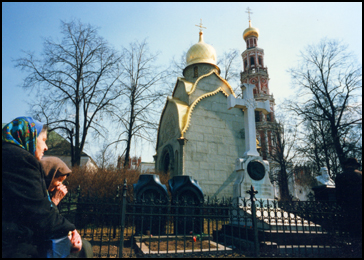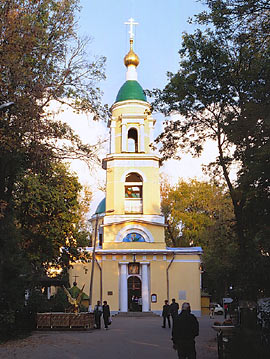 Try to imagine that you are reading a news report about complicated, emotional issues linked to death and the burial of the dead in the city of Jerusalem.
Now imagine that the reporter, while covering these issues, totally ignores the role of Judaism in that culture. Now, I realize that Jerusalem is a very diverse and even secular city, but can you imagine that?
Try to imagine that you are reading a news report about complicated, emotional issues linked to death and the burial of the dead in the city of Jerusalem.
Now imagine that the reporter, while covering these issues, totally ignores the role of Judaism in that culture. Now, I realize that Jerusalem is a very diverse and even secular city, but can you imagine that?
Now, Istanbul is a remarkably diverse and secular city, too. But can you imagine anyone writing a page-one news feature on death and burial without talking to Muslim clerics or devout believers? Can you imagine the story totally avoiding any of Islam's unique beliefs about the rites of death and burial of the dead?
Or how about Mexico City? There's another giant urban area that, in anyone's book, is very secular and contains a wide variety of believers and unbelievers. Yet it's hard to imagine a reporter writing this story without talking to Roman Catholic thinkers and leaders. Do we need to mention Rome? Paris? How about a London-based story on these topics that does not feature input from Anglicans and, in particular, the popularity of cremation among Anglicans (which represents a major change among historic, liturgical churches)?
You may have figured out where I am going with this. The Baltimore Sun recently printed a page-one news feature by foreign correspondent Erika Niedowski that began like this:
MOSCOW -- Larisa Korzhneva can't stop thinking about death -- not her own, but everyone else's. That's because Moscow, where she is deputy head of the municipal department that oversees burials, is running out of places to put its dead. And if she rests, she knows the deceased will soon have no place to.
"We don't have the right to sit still and do nothing," says Korzhneva, whose desk was recently outfitted with a huge bouquet of yellow and red irises that might have been fit for a funeral were they not looking a little dead themselves. "People will always need cemeteries."
About 130,000 of the more than 10.5 million who live in the Russian capital die every year. If Moscow does nothing, it will have enough space to bury its dead -- about half of whom, thankfully, choose cremation -- for five more years.
This is a good story and it's packed with all kinds of interesting details. However, I thought -- this will not surprise regular readers of this blog -- it was interesting that Niedowski included absolutely zero references to the role of Eastern Orthodox Christianity in shaping Russian culture and its view of death and dying and, now that you mention it, its rites and traditions linked to burial.
Active Orthodox believers would, for example, feel stung by the reporter's editorial insertion of the word "thankfully" in that reference to cremation. Obviously, cremation is a good thing in this story -- due to the cemetery space crisis. But did the reporter realize that the Orthodox, in keeping with traditions that date to the early church, actively oppose cremation? While doing background research, did Niedowski talk to any priests or historians about the culture's burial traditions and where they came from?
 The Orthodox are not alone in this belief. Here is a summary from a Scripps Howard column I did on a related topic not that long ago, linked to Roman Catholics and the issue of cremation. For most believers, I argued:
The Orthodox are not alone in this belief. Here is a summary from a Scripps Howard column I did on a related topic not that long ago, linked to Roman Catholics and the issue of cremation. For most believers, I argued:
The hardest liturgical changes to accept are those linked to emotional events at the crossroads of life -- birth, marriage and death.
"Cremation is no longer considered shocking to most Catholics," said Philip Lawler, editor of Catholic World Report. "But, overwhelmingly, traditional Catholics would lean toward a traditional burial. The older the Catholic, the more likely they would remember the traditions against cremation."
The modern Catechism of the Catholic Church hints at the ancient roots of this controversy, noting that cremation is permitted, "provided that it does not demonstrate a denial of faith in the resurrection of the body."
There's one other clue in the Sun story that Niedowski and her editors simply didn't check the religion side of this at all. Way down in the story, there is a reference to the fact that the Russian government continues offering one benefit from the Soviet era -- the entitlement to a "free" burial.
But "free" means one that doesn't cost more than about $150, the amount the city provides relatives of the vast majority of people who die. That gets the paperwork, a coffin -- a cheap one -- and a cotton blanket and tapochki, or slippers, for the deceased.
Now, that "cheap" coffin isn't, by any chance, made out of simple pine or some other humble wood? If so, this would be the coffin of choice for the Orthodox or, Catholics might recall, for the burial of most popes. Once again, there is a chance that this unexplained detail in the report is linked to the dominant faith in Mother Russia, whether the reporter knows it or not.
P.S. By the way, it is interesting to do some Google searches for photographs of the major cemetaries in Moscow, including those mentioned in the report. Two such images are used in this post. Very secular looking, wouldn't you say?
